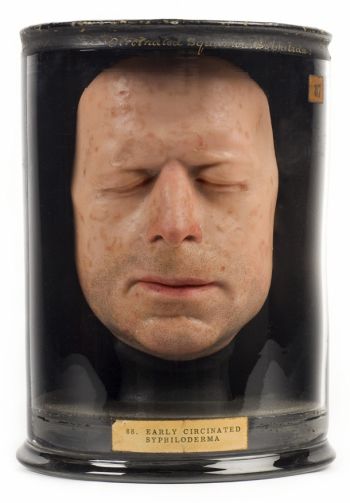Since time immemorial, humankind has held a fascination with its own mortality. Some of the earliest examples of civilisation are burial mounds, some of the earliest examples of art are tomb-paintings…

So it is only natural that the human animal should be fascinated by what goes on within its own fragile body. However, for various reasons – cultural taboos, religious laws, et cetera – this has not always been possible. In Roman times the practice of dissection was banned, so even Galen – the greatest physician of his time- was forced to experiment on Barbary macaques instead of human subjects. It was only in the fifteenth century that the practise was finally allowed in England – and even then in vastly limited and controlled circumstances. Even as late as the supposedly “enlightned” 21st century the renowned anatomist Gunther von Hagens faced public censure for presenting a live autopsy on British television.
So it takes some bravery for London’s elegant Wellcome Collection to present their ‘Exquisite Bodies‘ exhibition (on from July 30 until October 18, free to enter). Perhaps they get away with it by subtitling it “the curious and grotesque story of the anatomical model”, like it was some Victorian-era penny dreadful. Perhaps they get away with it by presenting it laid out in the manner of a resurrected circus freak-show. Perhaps they get away with it by warning that the exhibition “may not be suitable for under 18s” because of many reasons…
…but perhaps that doesn’t really matter, because this truly is a fascinating exhibition. Admittedly, there are less artefacts shown here than in previously – but then, as the guide they provide so kindly points out, many collections of anatomical wax were destroyed in the latter half of the 19th century by those who disapproved of them, or broken-up by exhibitors who feared a moral backlash.
Looking at the first few models – the earliest ones in the exhibition, including a haunting ‘Wax Venus‘ from 18th-century Florence and several perturbingly realistic ivory replicas – one cannot see what people found so frightening about these shows. Indeed, they are almost above reproach – their faces are peaceful, almost angelic, idealised in death. Moving further in to the exhibition and further down the timeline, however, you begin to see a darker side – the later models almost seem to be victims, with the viewer invited to leer guiltily at them in their glass cases… which is no surprise when you learn that many of the models were shown off in freak-shows. The old motto of “as I was, so you are, as I am, so shall you be” seems to hang unspoken in the air as you pass by these poor unfortunates: hideously realistic victims of syphilis alongside lepers, cyclopes and sword-swallowers gaze out glassy-eyed at you, but that’s just the beginning. The curtained-off recess featuring wax models of diseased male and female genitals is certainly not to be missed… and certainly not recommended to those of a nervous disposition. From there we move on to a shockingly realistic pregnant woman – the utter antithesis of the earlier Venus, this was death up close and personal, and I would not have been surprised to see her shambling about on the set of a George A Romero movie, so realistic was the model-maker’s art. Following her were photographs of models sadly now destroyed, posters advertising the long-gone freak-shows you might have found them in and a taxidermy of a two-headed calf… it was (to run the risk of sounding as melodramatic as those aforementioned Victorian Penny Dreadfuls) a veritable cavalcade of curiosity.
Sadly, I did not get any photos – one of the few downsides of this exhibition is that even if I had brought my camera the Wellcome Collection does not allow photography of it. On the one hand I can see why – these beautiful artefacts are delicate and easily damaged by bright lights, and there are those who would use them for sick pleasure instead of the pursuit of knowledge…
…but on the other hand I can’t help feeling a little cheated. After all, such beauty should be shared with as many people as possible, and therefore I urge anyone with an interest in the time period, or in the subject, or even just with the natural morbid curiosity found in every human being to check the exhibition out.
But do remember my warning about what lurked behind the curtained-off recess. And to know that I meant every word of it…
For more information visit the official website.






